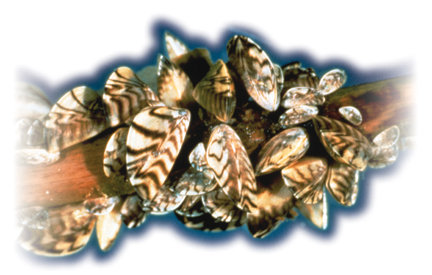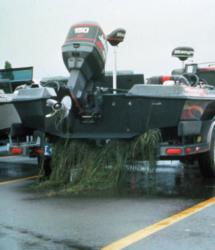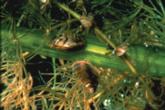Musseling in
Zebra Mussels and their impact on the Ohio River

Dreissena polymorpha, as zebra mussels are known scientifically, are small, no bigger than your thumbnail. They are triangular in shape with a pointed hinge. Their shells are glossy, usually light tan with bands of varying color. They look harmless enough but are, in fact, a serious ecological threat.
They were first discovered in North America in 1988 but were, in all probability, living with us for some time before that. The first infestations came through Lake St. Clair, located between Lake Huron and Lake Erie.
The zebra mussel probably entered this Great Lake through ballast water that was discharged by commercial transcontinental ships. It is known to be a native of the Black and Caspian seas. Shipping seems to be the only logical explanation for its introduction into North American waters.
After infesting Lake St. Clair, zebra mussels spread to the other Great Lakes, and by 1990, all were infected. Within a couple of years after that, they were found in the Ohio River as well as most of the waters of the Midwest.
Conventional wisdom has it that the Ohio River infestation came from Lake Erie. Not so, according to Patricia Morrison of the U.S. Fish and Wildlife Service, Ohio River Valley Ecosystem Team, Region 5. Early research clearly established that the infestation came from the lower pools of the Ohio River and spread upstream. Commercial barge traffic is believed to be the culprit. This conclusion is based on studies showing populations of zebra mussels downriver early in the 1990s. Only after a period of several years were they found in the upper pools of the river.
Morrison points out that their numbers exploded almost immediately. This is typical of nonnative species when they are first introduced into a new environment.
Zebra mussels reached frightening densities in the Ohio River by 1997 and 1998. In the Markland and McAlpine pools, from Cincinnati to Louisville, they were becoming a serious problem.
At mile 814, near Henderson, Ky., they reached densities as high as 40,000 adult zebra mussels per cubic meter of river bottom.
When asked about the Lake Erie experience, Morrison was quick to give credit where credit was due. She agreed that they have the effect of clearing the water. She further conceded that clear water allows for more and deeper weed growth, which improves the fishing – especially for sight-feeders like black bass. She notes, however, that clear water is not necessarily clean water.
 In the long term, she points out that zebra mussels are harmful to the environment, which in turn is harmful to smallmouth bass. Zebra mussels filter suspended solids, including plant life, from the water. Over a long period of time, this will harm the fishery by removing the food supply for those creatures at the bottom of the food chain upon which predators, at the top of the food chain, depend.
In the long term, she points out that zebra mussels are harmful to the environment, which in turn is harmful to smallmouth bass. Zebra mussels filter suspended solids, including plant life, from the water. Over a long period of time, this will harm the fishery by removing the food supply for those creatures at the bottom of the food chain upon which predators, at the top of the food chain, depend.
The Ohio River experience was similar to that of Lake Erie, at least up to the summer of 2000. As the population of zebra mussels increased, the water clarity improved. Once during the fall of 1998 there were places in the Ohio River where visibility was 15 feet. To put that into perspective, most fishing reports for the river will consider visibility of 3 to 4 feet excellent.
The zebra mussel’s ability to clear water is understandable if you consider a couple of facts. An adult female can produce up to a million eggs during one spawning season. On top of that, a mature zebra mussel can filter up to 2 liters of water in a 24-hour period. Simple math tells the tale – millions and millions of zebra mussels times 2 liters of water times 24 hours times 30 days in a month times …
The effect on the river was dramatic. Anglers began finding weeds in places they had never found them. Not just a few weeds, either – acres and acres of them. They were growing at depths of 10 feet or more in some locations. This, according to Morrison, was a direct result of the clear water. The effect was especially noticeable in the fall when zebra mussels are most efficient due to the stable water.
Then, just as panic was about to set in, among scientists if not anglers, a strange thing happened – most of the zebra mussels died. They were there in the early spring of 2000, but by summer, their population had decreased by 90 percent.
Morrison and her colleagues found, during their dives and sampling, that the zebra mussels were gone – just gone. All they found were thin, pitted shells, “as if they had been sandblasted,” Morrison said.
There are several theories for the crash. The most popular is that the high water levels and swift current throughout the spring and into the summer of 2000 caused the suspended solids in the water to wear away the shells. Another explanation is that some form of bacteria killed them. Yet a third theory is that, as native lake dwellers, they do not do well in moving water.
 For whatever reason, their numbers were down by 90 percent, and they have not rebounded. In fact, they show no signs of rebounding in the foreseeable future. Morrison reports few second- and third-year-class zebra mussels in the Ohio River at this time.
For whatever reason, their numbers were down by 90 percent, and they have not rebounded. In fact, they show no signs of rebounding in the foreseeable future. Morrison reports few second- and third-year-class zebra mussels in the Ohio River at this time.
On the positive side, native mollusks, which were hit especially hard by the zebra mussel infestation, are beginning to rebound, although it will take them decades to recover fully. The zebras attach themselves to the native mollusks, restricting their ability to feed, grow, move, breathe and reproduce.
On the negative side, weedbeds are not as prevalent as they were a few years ago, and most are dead or dying. The water is not as clear as it used to be, either, especially in the fall.
Anecdotal reports from anglers, as well as data from government sources, indicate that the smallmouth bass population is improving in the upper pools of the river. Certainly the striper and hybrid striper populations are on the rise from the Greenup Pool all the way to the mouth of the Mississippi.
Largemouth bass, while not spectacular, are good and may be getting better, especially in the lower pools from Louisville down to Dam No. 53. The Smithland pool has produced several 7- and 8-pound largemouths in the last several years.
The infestation of zebra mussels may have helped the sight-feeding fish by clearing the water, increasing the weed growth and generally making a better environment for them. It may have given them an opportunity to feed, grow and reproduce while providing habitat for the fry.
At the same time, a long-term disaster was averted by the sudden and unexpected decline of the zebra mussels. They were gone before they could permanently damage the fishery by destroying the lower rungs of the food chain.
Maybe the Ohio River got lucky. Maybe it benefited from the best of two worlds – a world with, and a world without, the zebra mussel. Time will tell.
Black bass
The zebra mussel invasion may have been helpful for largemouth bass living in the Ohio River, at least in the short run.
Chris Dornbusch, a storied Ohio River tournament angler, says that the proliferation of grass beds during the height of the infestation was beneficial for black bass.
Dornbusch and others have long held the belief that the major problem in the Ohio River was lack of spawning habitat. He points out that many acres are lost each year to silting and erosion, destroying shallow, backwater areas.
Although the zebra mussels certainly did not create spawning habitat, they did improve water clarity, which allowed for weed growth. As a result, the fry had somewhere safe to hide.
This should improve catch rates, at least for a few years.
Controlling zebra mussels is difficult under the best of circumstances. It is nearly impossible in open, moving water systems such as rivers.
Research is under way to develop chemicals that will target zebra mussels but ignore native mollusks and other animals. Until that research is completed, and an effective way to use it is developed, we must all do our part to control the zebra’s spread.
Angler and boater efforts are important. Experts recommend the following:
Clean your boat, motor and trailer with soap and water. Use high-pressure water if necessary.
Clean livewells thoroughly – again, use soap and water.
Store your rig in a dry area for several days after use.
Report findings and sightings immediately.
For more information about zebra mussels, visit miseagrant.umich.edu.
